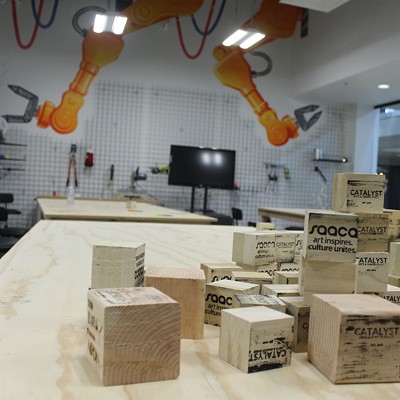Not only is this the result of a divorce between two of the community's oldest music organizations, but it may also be a sign of financial troubles at the Tucson Symphony Orchestra (TSO).
Terry Marshall, public relations manager for the symphony, acknowledges that for several years, the organization has annually spent $500,000 more than the approximately $3.8 million it raises. That situation, he points out, is a structural operating deficit common with orchestras across the country, and it isn't "going to go away for the foreseeable future."
To help raise funds, the Tucson Symphony Women's Association (TSWA) was organized in 1952. Starting in the 1980s, the group also began providing free music lessons to underserved children.
To pay for these programs, the TSWA for 49 years sponsored a cotillion, with last year's event reportedly raising $37,000. But in January, the ball's organizing committee decided to work directly with the Tucson Symphony Society, the body that governs the TSO.
"We did it purely on a business decision," says Julie Beach, who is secretary of the cotillion committee. "It seemed to be logical."
According to Evelyn Gerzetic, president of the TSWA, that shift meant her organization lost its biggest fundraiser.
Two months after that blow, Gerzetic notes in a recent newsletter, the Tucson Symphony Society requested that the TSWA "change its primary activities" away from their music school and toward supporting the orchestra.
After that suggestion was made, Marshall says, the TSS didn't hear anything from the women's association for quite some time.
Gerzetic states in her newsletter that at a May meeting with the TSS, her group was asked for a projection of future revenues it could provide. She says TSWA responded by indicating it couldn't estimate these amounts, but expected to support the symphony for another 50 years.
The level of that support in the past has been substantial. Records show that over a three-year period, the TSWA contributed about $50,000, then $71,000, and finally $170,000, of which $100,000 was an endowment contribution. Last year, according to Gerzetic, another $84,000 was donated, bringing the total to more than $1 million since 1993.
On July 5, TSS attorney and president-elect Erwin Kratz wrote the TSWA. He suggested that in return for the continued use under Internal Revenue Service rules of the name "Tucson Symphony Women's Association," the TSWA pledge two-thirds to three-quarters of its annual revenues to the orchestra.
When the TSWA didn't comply, the TSS board of directors unanimously voted to sever the relationship between the two organizations.
"They're raising funds for their own music education programs which reach 100," Marshall explains of the vote. "Our programs reach over 35,000 in schools through a combination of lessons and concerts. Because the TSWA contributions were steadily declining, the TSS board didn't feel there was any point in continuing (the relationship)."
The split left many in the TSWA dumbfounded.
"It is really not about the immediate income lost," one woman wrote, "but about the relationship TSS has lost. You just don't piss off several hundred women."
Marshall replies: "I'm sorry so many women are upset, but I don't see why." He indicates that most of the TSWA members weren't symphony supporters, nor did they attend concerts.
Based on the TSS decision, the signs on the TSWA's three buildings at the corner of Stone Avenue and 15th Street were recently altered, painting over the word "Tucson." But the structures continue to house both the group's music school and thrift shop.
The future ownership of these buildings, though, may be in question. Kratz has written that the TSS "reserves the option of filing suit to determine the status of all of TSWA's assets, if TSWA makes that necessary."
Although Marshall says the lost TSWA operating donations have been replaced, the TSWA properties may make an attractive target for a group short on funds. The Pima County Assessor's Office values the properties for tax purposes at just less than $500,000, meaning their market value should be considerably more.
But TSS board president Nancy March denies any interest in legally pursuing the structures. "I'm not aware of that," she says, "and don't believes it's the case."
Some new funds could certainly help the orchestra. Its current financial situation has required the TSS, in ongoing negotiations, to offer symphony musicians a contract characterized as calling "for large cuts in musicians' pay and benefits. Also cuts in orchestra positions and a hiring freeze."
Additionally, the TSS last December signed a $1.5 million variable-rate promissory note with Northern Trust Company to obtain a line of credit. This deed of trust is secured by the office building the TSS owns and occupies at 2175 N. Sixth Ave.
Marshall says of the TSS: "We have a long-term plan against future revenue losses." He emphasizes that receipts from ticket sales have gone up, that sponsorships have increased and that a new ticketing procedure should generate more revenue.
On the other hand, Marshall admits the symphony's hopes for additional planned giving haven't materialized so far. "Our marketing side had a good season," he says, "but the development side was not what was expected."
One setback came in May. Because of a dispute with the TSS board, a donor who had contributed hundreds of thousands of dollars withdrew his estate bequest of at least another $250,000. "My money goes where I am needed, not where I am insulted," he said.
Meanwhile, the TSS cotillion will be held Nov. 23, with 36 participants. At the same time, the TSWA is hoping to hold a similar function next spring to raise funds for a grant program to support local musical groups.
"We'll continue to be very active," Gerzetic says, "and if the TSS needs a grant, they can apply for one."












